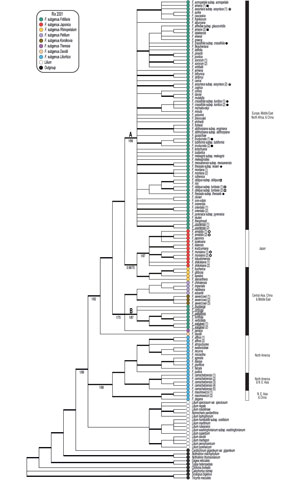NEWS 2014
Evolutionary relationships in the medicinally important genus Fritillaria L. (Liliaceae)
Peter D. DAY¹,², Madeleine BERGER¹,³,⁵, Laurence HILL⁴, Michael F. FAY¹, Andrew R. LEITCH², Ilia J. LEITCH¹, Laura J. KELLY¹,²
Molecular Phylogenetics and Evolution 80:11-19 (2014)
doi:10.1016/j.ympev.2014.07.024
¹Jodrell Laboratory, Royal Botanic Gardens, Kew, Richmond, Surrey TW9 3DS, UK
²Queen Mary University of London, school of Biological and Chemical Sciences, London E1 4NS, UK,
³School of Biological and Biomedical Science, Durham University, South Road, Durham DH1 3LE, UK
⁴Petersham Lodge, River Lane, Richmond, Surrey TW10 7AG, UK
⁵Present address: Rothamstead Research, West Common, Harpenden, Hertfordshire AL5 2JQ, UK
Abstract
Fritillaria (Liliaceae) is a genus of approximately 140 species of bulbous perennial plants that includes taxa of both horticultural and medicinal importance. As well as being commercially valuable, Fritillaria species have attracted attention because of their exceptionally large genome sizes, with all values recorded to date in excess of 30 Gb. Despite such interest in the genus, phylogenetic relationships between the majority of species have remained untested. Here we present the first phylogenetic reconstruction of relationships to encompass most of the currently recognised species diversity in the genus. Three regions of the plastid genome were sequenced in 117 individuals of Fritillaria, representing 92 species (c. 66% of the genus) and in representatives of nine other genera of Liliaceae. Eleven low-copy nuclear gene regions were also screened in selected species for their potential utility. Phylogenetic analysis of a combined plastid dataset using maximum parsimony and Bayesian inference provided support for the monophyly of the majority of currently recognised subgenera. However, subgenus Fritillaria, which is by far the largest of the subgenera and includes the most important species used in traditional Chinese medicine, is found to be polyphyletic. Moreover, several taxa that were represented by multiple individuals show evidence of species non-monophyly. The Japanese endemic subgenus Japonica, which contains the species with the largest recorded genome size for any diploid plant, is resolved as sister to the predominantly Middle Eastern and Central Asian subgenus Rhinopetalum. Whilst relationships between most of the major Fritillaria lineages can now be resolved, our results also highlight the need for data from additional independently evolving loci; an endeavour that may be particularly challenging in light of the huge nuclear genomes found in these plants.




